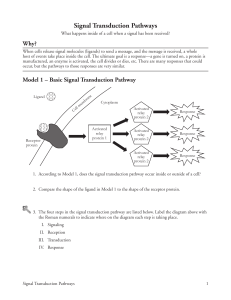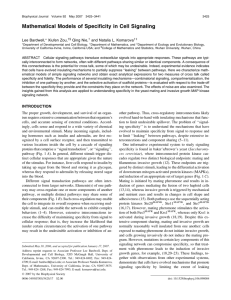Cell Signaling and Disease
advertisement
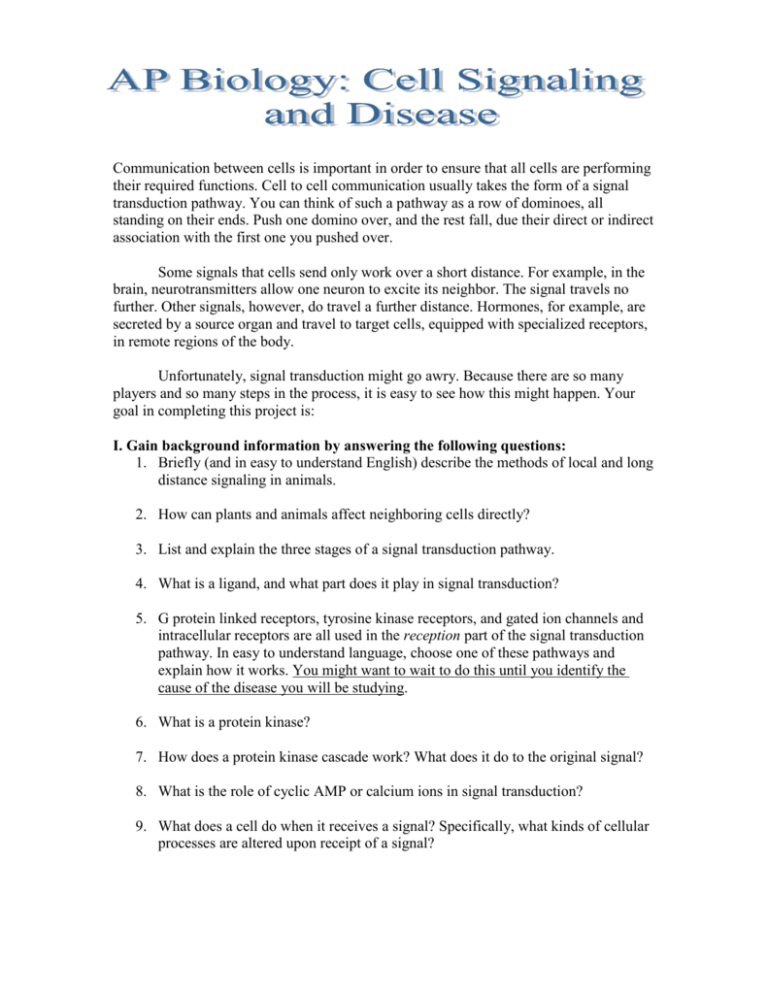
Communication between cells is important in order to ensure that all cells are performing their required functions. Cell to cell communication usually takes the form of a signal transduction pathway. You can think of such a pathway as a row of dominoes, all standing on their ends. Push one domino over, and the rest fall, due their direct or indirect association with the first one you pushed over. Some signals that cells send only work over a short distance. For example, in the brain, neurotransmitters allow one neuron to excite its neighbor. The signal travels no further. Other signals, however, do travel a further distance. Hormones, for example, are secreted by a source organ and travel to target cells, equipped with specialized receptors, in remote regions of the body. Unfortunately, signal transduction might go awry. Because there are so many players and so many steps in the process, it is easy to see how this might happen. Your goal in completing this project is: I. Gain background information by answering the following questions: 1. Briefly (and in easy to understand English) describe the methods of local and long distance signaling in animals. 2. How can plants and animals affect neighboring cells directly? 3. List and explain the three stages of a signal transduction pathway. 4. What is a ligand, and what part does it play in signal transduction? 5. G protein linked receptors, tyrosine kinase receptors, and gated ion channels and intracellular receptors are all used in the reception part of the signal transduction pathway. In easy to understand language, choose one of these pathways and explain how it works. You might want to wait to do this until you identify the cause of the disease you will be studying. 6. What is a protein kinase? 7. How does a protein kinase cascade work? What does it do to the original signal? 8. What is the role of cyclic AMP or calcium ions in signal transduction? 9. What does a cell do when it receives a signal? Specifically, what kinds of cellular processes are altered upon receipt of a signal? II. Use the resources that accompany your book. You may want to utilize the activities for Chapter 11 at THE BIOLOGY PLACE and other websites. III. Investigate the particulars of a disease caused by faulty cell-to-cell communication. Because the response that a cell usually has to signaling is so important and provides the means for so many other functions of the organism, you can imagine that a failure to relay signals property could result in a multitude of diseases. You and your partner will be assigned one disease. Using pictures, diagrams, and words, you will create a poster that incorporates the elements in questions 1-9, as well as specific details about the disease you’ve been assigned and how it is related to questions 1-9. In your poster, you need to include both an explanation of proper intercellular communication, as well as an explanation of how your disease deviates from that. For example, if your disease involves faulty gated ion channels, be sure that your poster includes information about correctly functioning gated ion channels too. I do not expect you to doing graduate level work, but I do expect you to be able to explain, in your own words, the basics of the pathway and the way in which failure of the pathway leads to disease. You may choose one of these or find your own. Any topic other than those listed below needs to be approved first. Diabetes and Insulin Resistance Cystic Fibrosis Norrie disease Multiple Sclerosis Kidney disease Alopecia Ataxia Telangiectasia Alzheimer disease Tuberous Sclerosis Parkinson’s disease Pancreatic Cancer Neurofibromatosis Chronic Myelogenous Leukemia (CML) Werner syndrome Heart disease – Congenital Heart disease or Cardiomyocyte hypertrophy CRITERIA: 1. Use a “science fair type” of poster board. These are thicker than regular poster board material. It is preferable that you find one that is divided into thirds. 2. All information must be typed. You must have a title in 240-point type. This is equivalent to 4 inches. (You can always enlarge words on a copier or buy letters.) All information must be broken down into logical sections. Each section should have a title that is 84-point type or 1.5 inches. Use a font that is easy to read. The text should be at least 16 points in size. (You can have more than one page per section if necessary.) 3. Your names should be in the bottom right-hand corner in 60-point type. 4. You must have a list of your references. Use the correct MLA format. This should be in the bottom left hand corner. References must be in 14-point type and fit on an 8.5 X 11” piece of paper. 5. You must include at least 3 graphics. The minimum size is 8.5 X 11”, in order to be easily seen. Required graphics are as follows: a. A drawing of the chromosome showing the location of the affected gene. b. A picture or drawing of a person with the genetic disease or a picture or drawing of organs and/or tissues affected by the disease. c. A picture or drawing of the type of cell signaling pathway(s) involved. (A working pathway or a faulty pathway) 6. Breakdown/organization of information: a. Introduction – a brief overview of cell-to-cell communication. b. Specific Information – incorporating the elements in question 1 – 9. c. General information about the disease – means of inheritance (Is it autosomal or sex-linked? Is it a dominant or recessive trait?) d. Cause of the disease – name the gene and chromosome number and describe the mutation that causes the disease. e. Symptoms – describe the symptoms of the disease and/ or the physical characteristics of a person affected by the disease. Here are some good places to start: http://fig.cox.miami.edu/~cmallery/150/memb/cellcomm.htm http://www.case.edu/pubaff/univcomm/cell-rsch.htm http://www.cellsignal.com/reference/pathway/index.jsp http://anatomy.med.unsw.edu.au/cbl/GENOME/Genes_Diseases/Signals/signals_overview.htm http://www.news-medical.net/?id=72 http://www.emedicine.com/ http://www.bioteach.ubc.ca/CellBiology/CellSurfaceReceptors/ http://rarediseases.info.nih.gov/ http://www.cellsignallingbiology.org/ http://www.kumc.edu/gec/support http://www.ygyh.org http://www.ncbi.nlm.nih.gov/projects/genome/guide/human/ http://medgen.genetics.utah.edu/photographs.htm http://www.sigmaaldrich.com/Area_of_Interest/Life_Science/Cell_Signaling/Scientific_ Resources/Pathway_Slides___Charts.html http://www.genome.gov/ You can also use books and journals in the library to find information.
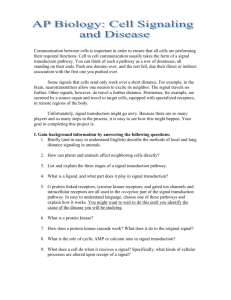

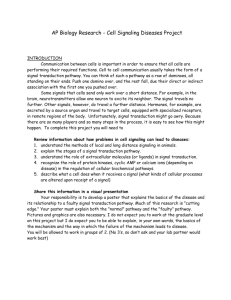
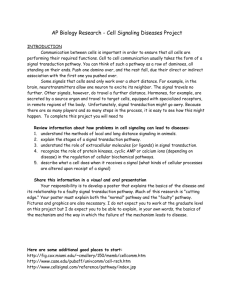




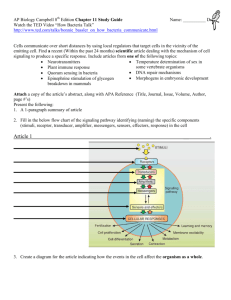

![Major Change to a Course or Pathway [DOCX 31.06KB]](http://s3.studylib.net/store/data/006879957_1-7d46b1f6b93d0bf5c854352080131369-300x300.png)
